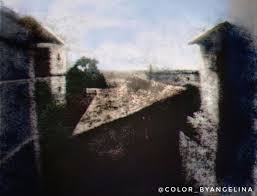The First Photograph: A Historic Moment Captured in Time
Photography, as we know it today, has a rich and fascinating history that dates back to the early 19th century. The first photograph ever taken marked a monumental moment in the evolution of visual art and technology.
On a sunny day in 1826, French inventor Joseph Nicéphore Niépce successfully captured the world’s first permanent photograph. Using a camera obscura and a pewter plate coated with bitumen of Judea, Niépce exposed the plate to light for several hours. Through this groundbreaking process, an image of the view from his window at Le Gras was imprinted onto the plate.
This historic photograph, known as “View from the Window at Le Gras,” not only documented a specific scene but also symbolised the birth of a new era in visual communication. It laid the foundation for future advancements in photography and paved the way for modern-day photography techniques.
Despite its simplicity by today’s standards, the first photograph remains a testament to human ingenuity and creativity. It serves as a reminder of our innate desire to capture and preserve moments in time, transcending language and cultural barriers.
As we reflect on this historic milestone, we are reminded of the power of photography to immortalise memories, evoke emotions, and inspire generations to come. The first photograph stands as a timeless tribute to the artistry and innovation that continue to shape our world today.
7 Essential Tips for Capturing Your First Photograph
- Ensure good lighting for clear and bright photos.
- Use the rule of thirds for a balanced composition.
- Experiment with different angles to find interesting perspectives.
- Focus on your subject to make it the main focal point of the photo.
- Keep your camera steady to avoid blurry images.
- Consider the background to avoid distractions in your photo.
- Practice and explore different settings on your camera to improve your photography skills.
Ensure good lighting for clear and bright photos.
To capture clear and bright photos, it is essential to ensure good lighting. Adequate lighting plays a crucial role in photography, enhancing the clarity and vibrancy of the images. Whether shooting indoors or outdoors, paying attention to lighting conditions can make a significant difference in the quality of your photos. By utilising natural light or artificial lighting sources effectively, you can create visually appealing photographs that truly shine with clarity and brightness.
Use the rule of thirds for a balanced composition.
When capturing your first photograph, remember to apply the rule of thirds to achieve a balanced composition. By dividing your frame into nine equal parts with two horizontal and two vertical lines, this principle guides you to place key elements off-centre for a more visually appealing and dynamic image. Embracing the rule of thirds can enhance the overall composition of your photograph and draw viewers’ attention to the focal point, creating a sense of harmony and intrigue in your visual storytelling.
Experiment with different angles to find interesting perspectives.
When delving into the realm of photography, it is essential to remember the importance of experimentation with various angles to discover captivating perspectives. By exploring different vantage points and viewpoints, photographers can breathe new life into their subjects and unveil unique dimensions within their compositions. Embracing a spirit of curiosity and creativity in adjusting angles can lead to striking visuals that engage viewers and offer fresh insights into the art of photography.
Focus on your subject to make it the main focal point of the photo.
When capturing your first photograph, it is essential to focus on your subject to ensure that it becomes the main focal point of the image. By maintaining a sharp and clear focus on your subject, you can draw attention to the key elements of the scene and create a visually engaging composition. This technique not only highlights the subject’s details and textures but also adds depth and dimension to your photograph, making it more compelling and impactful for viewers. Remember, focusing on your subject can help convey the intended message or story effectively through your first photograph.
Keep your camera steady to avoid blurry images.
To capture clear and sharp images, it is crucial to keep your camera steady while taking photos. By maintaining a stable grip and minimizing any unnecessary movements, you can prevent blurriness in your images. Whether using a professional DSLR camera or a smartphone, ensuring stability is key to producing high-quality photographs. Remember, a steady hand can make all the difference between a crisp image and a disappointing blur.
Consider the background to avoid distractions in your photo.
When capturing your first photograph, it is essential to consider the background to prevent distractions that may take away from the main subject of your image. By choosing a simple or neutral background, you can ensure that the focus remains on your intended subject, allowing it to stand out and make a more significant impact. Paying attention to the background can enhance the overall composition of your photo and create a more visually appealing result that effectively conveys your message or story.
Practice and explore different settings on your camera to improve your photography skills.
To enhance your photography skills, it is essential to practice and explore different settings on your camera. By experimenting with settings such as aperture, shutter speed, ISO, and white balance, you can gain a deeper understanding of how each element contributes to the overall composition of your photos. This hands-on approach not only allows you to capture a wider range of subjects in varying lighting conditions but also helps you develop your unique style as a photographer. Remember, mastery comes with practice, so don’t be afraid to step out of your comfort zone and push the boundaries of your creative vision through continuous exploration and experimentation with your camera settings.

